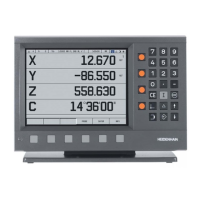POSITIP 880 97
I – 9 POSITIP 880 Turning Functions
Fundamentals of Positioning
Introduction
The geometry of a workpiece is described by a rectangular or
Cartesian coordinate system (named in honor of the French
mathematician and philosopher René Descartes, in Latin Renatus
Cartesius, 1596 to 1650). The Cartesian coordinate system consists of
three mutually perpendicular axes X, Y and Z. The point of intersection
of these axes is called the datum (or origin) of the coordinate system.
See Fig. I.73.
To determine positions on a workpiece, the coordinate system is
“laid” onto the workpiece. With lathe work (i.e. rotationally
symmetrical workpieces), the Z axis moves along the axis of rotation
while the X axis moves in the direction of the radius or diameter. The
Y axis can be disregarded since it would always have the same values
as the X axis. See Fig. I.74.
Fig. I.73 Cartesian coordinate system
Fig. I.74 The Cartesian coordinate with lathe work

